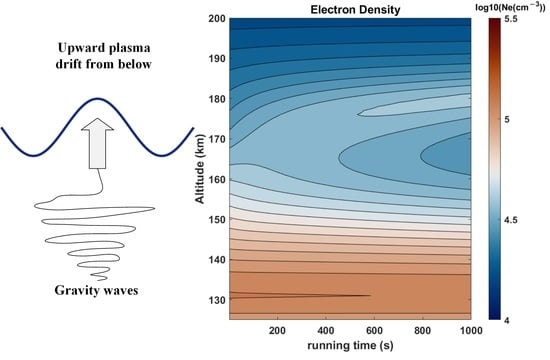Simulation of Transient Topside Layer in the Martian Ionosphere
Abstract
1. Introduction
2. Model of Daytime Martian Ionosphere and Descriptions
3. Results and Discussion
4. Conclusions
Author Contributions
Funding
Data Availability Statement
Acknowledgments
Conflicts of Interest
References
- Patzold, M.; Tellmann, S.; Hansler, B.; Hinson, D.; Schaa, R.; Taylet, G.L. A sporadic third layer in the ionosphere of Mars. Science 2005, 310, 837–839. [Google Scholar] [CrossRef] [PubMed]
- Hinson, D.P.; Simpson, R.A.; Twicken, J.D.; Tyler, G.L.; Flasar, F.M. Initial results from radio occultation measurements with Mars Global Surveyor. J. Geophys. Res. 1999, 104, 26997–27012. [Google Scholar] [CrossRef]
- Jakosky, B.M.; Lin, R.P.; Grebowsky, J.M.; Luhmann, J.G.; Mitchell, D.F.; Beutelschies, G.; Priser, T.; Acuna, M.; Andersson, L.; Baird, D.; et al. The Mars Atmosphere and Volatile Evolution (MAVEN) Mission. Space Sci. Rev. 2015, 195, 3–48. [Google Scholar] [CrossRef]
- Rishbeth, H.; Mendillo, M. Ionospheric layers of Mars and Earth. Planet. Space Sci. 2004, 52, 849–852. [Google Scholar] [CrossRef]
- Grebowsky, J.M.; Benna, M.; Plane, J.M.C.; Collinson, G.A.; Mahaffy, P.R.; Jakosky, B.M. Unique, non-Earthlike, meteoritic ion behavior in upper atmosphere of Mars. Geophys. Res. Lett. 2017, 44, 3066–3072. [Google Scholar] [CrossRef]
- Crismani, M.; Schneider, N.; Plane, J.; Evans, J.S.; Jain, S.K.; Chaffin, M.S.; Carrillo-Sanchez, J.D.; Deighan, J.I.; Yelle, R.V.; Stewart, A.I.F.; et al. Detection of a persistent meteoric metal layer in the Martian atmosphere. Nature Geosci. 2017, 10, 401–404. [Google Scholar] [CrossRef]
- Hanson, W.B.; Sanatani, S.; Zuccaro, D.R. The martian ionosphere as observed by the viking retarding potential analyzers. J. Geophys. Res. 1977, 82, 4351–4363. [Google Scholar] [CrossRef]
- Mayyasi, M.; Withers, P.; Fallows, K. A sporadic topside layer in the ionosphere of Mars from analysis of MGS radio occultation data. J. Geophys. Res. Space Phys. 2018, 123, 883–900. [Google Scholar] [CrossRef]
- Mukundan, V.; Thampi, S.V.; Bhardwaj, A. M3 electron density layer in the dayside ionosphere of Mars: Analysis of MAVEN ROSE observations. Icarus 2022, 384, 115062. [Google Scholar] [CrossRef]
- Zhang, M.H.G.; Luhmann, J.G.; Kliore, A.J.; Kim, J. A post-Pioneer Venus reassessment of the Martian dayside ionosphere as observed by radio occultation methods. J. Geophys. Res. 1990, 95, 14829–14839. [Google Scholar] [CrossRef]
- Lillis, R.J.; Fillingim, M.O.; Peticolas, L.M.; Brain, D.A.; Lin, R.P.; Bougher, S.W. Nightside ionosphere of mars: Modeling the effects of crustal magnetic fields and electron pitch angle distributions on electron impact ionization. J. Geophys. Res. 2009, 114, E11009. [Google Scholar] [CrossRef]
- Terada, N.; Machida, S.; Shinagawa, H. Global hybrid simulation of the Kelvin-Helmholtz instability at the Venus ionopause. J. Geophys. Res. 2002, 107, 1471. [Google Scholar] [CrossRef]
- Zhang, Z.; Orosei, R.; Huang, Q.; Zhang, J. Topside of the Martian ionosphere near the terminator: Variation with season and solar zenith angle and implications for the origin of the transient layers. Icarus 2015, 251, 12–25. [Google Scholar] [CrossRef]
- Kopf, A.J.; Gurnett, D.A.; DiBraccio, G.A.; Morgan, D.D.; Halekas, J.S. The transient topside layer and associated current sheet in the ionosphere of Mars. J. Geophys. Res. Space Phys. 2017, 122, 5579–5590. [Google Scholar] [CrossRef]
- Shinagawa, H.; Cravens, T. The ionospheric effects of a weak intrinsic magnetic field at Mars. J. Geophys. Res. 1992, 97, 1027–1035. [Google Scholar] [CrossRef]
- Collinson, G.A.; McFadden, J.; Grebowsky, J.; Mitchell, D.; Lillis, R.; Withers, P.; Vogt, M.F.; Benna, M.; Espley, J.; Jakosky, B. Constantly forming sporadic E-like layers and rifts in the martian ionosphere and their implications for earth. Nat. Astron. 2020, 4, 486–491. [Google Scholar] [CrossRef]
- Fox, J.L.; Yeager, K.E. Morphology of the near-terminator Martian ionosphere: A comparison of models and data. J. Geophys. Res. 2006, 111, A10309. [Google Scholar] [CrossRef]
- Andrews, D.J.; André, M.; Opgenoorth, H.J.; Edberg, N.T.; Diéval, C.; Duru, F.; Gurnett, D.A.; Morgan, D.; Witasse, O. Oblique reflections in the Mars Express MARSIS data set: Stable density structures in the Martian ionosphere. J. Geophys. Res. Space Phys. 2014, 119, 3944–3960. [Google Scholar] [CrossRef]
- Wang, J.-S.; Nielsen, E. Possible hydrodynamic waves in the topside ionospheres of Mars and Venus. J. Geophys. Res. 2002, 107, SIA-2. [Google Scholar] [CrossRef]
- Wang, J.-S.; Nielsen, E. Wavelike structures in the Martian topside ionosphere observed by Mars Global Surveyor. J. Geophys. Res. 2003, 108, 5078. [Google Scholar] [CrossRef]
- Wang, X.-D.; Wang, J.-S.; Nielsen, E.; Zou, H. “Hook” structure in MARSIS ionogram and its interpretation. Geophys. Res. Lett. 2009, 36, L13103. [Google Scholar] [CrossRef]
- Mendillo, M.; Phillips, S.R.; Narvaez, C.; Mayyasi, M.; Thiemann, E.; Benna, M.; Eparvier, F.; Chamberlin, P.; Mahaffy, P.; Andersson, L. On the altitude patterns of photo-chemical-equilibrium in the Martian ionosphere: A special role for electron temperature. J. Geophys. Res. Space Phys. 2021, 126, e2020JA028366. [Google Scholar] [CrossRef]
- Balan, N.; Bailey, G.J.; Abdu, M.A.; Oyama, K.I.; Richards, P.G.; MacDougall, J.; Batista, I.S. Equatorial plasma fountain and its effects over three locations: Evidence for an additional layer, the F3 layer. J. Geophys. Res. 1997, 102, 2047–2056. [Google Scholar] [CrossRef]
- Jiang, C.; Yang, G.; Liu, J.; Zhao, Z. Reply to Comment by Lynn et al. on “A study of the F2 layer stratification on ionograms using a simple model of TIDs”. J. Geophys. Res. Space Phys. 2020, 125, e2020JA027785. [Google Scholar] [CrossRef]
- Jiang, C.; Yang, G.; Liu, J.; Zhao, Z. A study of the F2 layer stratification on ionograms using a simple model of TIDs. J. Geophys. Res. Space Phys. 2019, 124, 1317–1327. [Google Scholar] [CrossRef]
- Schunk, R.; Nagy, A. Ionospheres: Physics, Plasma Physics, and Chemistry; Cambridge University Press: New York, NY, USA, 2000. [Google Scholar]
- Tobiska, W.K. SOLAR2000 Irradiances for Climate Change Research, Aeronomy and Space System Engineering. Adv. Space Res. 2004, 34, 1736–1746. [Google Scholar] [CrossRef]
- Verner, D.A.; Yakovlev, D.G. Analytic FITS for Partial Photoionization Cross Sections. Astron. Astrophys. Suppl. Ser. 1995, 109, 125–133. [Google Scholar]
- Verner, D.A.; Ferland, G.J.; Korista, K.T.; Yakovlev, D.G. Atomic Data for Astrophysics. II. New Analytic Fits for Photoionization Cross Sections of Atoms and Ions. arXiv 1996. [Google Scholar] [CrossRef]
- Morgan, D.D.; Gurnett, D.A.; Kirchner, D.L.; Fox, J.L.; Nielsen, E.; Plaut, J.J. Variation of the Martian ionospheric electron density from Mars Express radar soundings. J. Geophys. Res. 2008, 113, A09303. [Google Scholar] [CrossRef]
- Vogt, M.F.; Withers, P.; Fallows, K.; Andersson, L.; Girazian, Z.; Mahaffy, P.R.; Benna, M.; Elrod, M.K.; Connerney, J.E.; Espley, J.R.; et al. MAVEN observations of dayside peak electron densities in the ionosphere of Mars. J. Geophys. Res. Space Phys. 2017, 122, 891–906. [Google Scholar] [CrossRef]
- Yiğit, E.; Medvedev, A.S.; Hartogh, P. Variations of the Martian Thermospheric Gravity-wave Activity during the Recent Solar Minimum as Observed by MAVEN. Astrophys. J. 2021, 920, 69. [Google Scholar] [CrossRef]
- Matta, M.; Galand, M.; Moore, L.; Mendillo, M.; Withers, P. Numerical simulations of ion and electron temperatures in the ionosphere of Mars: Multiple ions and diurnal variations. Icarus 2014, 227, 78–88. [Google Scholar] [CrossRef]
- Bailey, D.K. The geomagnetic nature of the F2 layer longitude effect. J. Geophys. Res. 1948, 53, 35–39. [Google Scholar] [CrossRef]
- Sen, H.Y. Stratification of the F2 layer of the ionosphere over Singapore. J. Geophys. Res. 1949, 54, 363–366. [Google Scholar] [CrossRef]
- Yiğit, E.; England, S.L.; Liu, G.; Medvedev, A.S.; Mahaffy, P.R.; Kuroda, T.; Jakosky, B.M. High-altitude gravity waves in the Martian thermosphere observed by MAVEN/NGIMS and modeled by a gravity wave scheme. Geophys. Res. Lett. 2015, 42, 8993–9000. [Google Scholar] [CrossRef]
- Terada, N.; Leblanc, F.; Nakagawa, H.; Medvedev, A.S.; Yiğit, E.; Kuroda, T.; Hara, T.; England, S.L.; Fujiwara, H.; Terada, K.; et al. Global distribution and parameter dependences of gravity wave activity in the Martian upper thermosphere derived from MAVEN/NGIMS observations. J. Geophys. Res. Space Phys. 2017, 122, 2374–2397. [Google Scholar] [CrossRef]
- Collinson, G.; McFadden, J.; Mitchell, D.; Grebowsky, J.; Benna, M.; Espley, J.; Jakosky, B. Traveling ionospheric disturbances at Mars. Geophys. Res. Lett. 2019, 46, 4554–4563. [Google Scholar] [CrossRef]
- Jiang, C.; Yokoyama, T.; Wei, L.; Yang, G.; Zhao, Z. Nonlinear Simulation of Ionospheric Irregularities at Mars. Astrophys. J. 2021, 909, 47. [Google Scholar] [CrossRef]
- Tian, R.; Jiang, C.; Yang, G.; Yin, W.; Zhang, Y.; Zhao, Z. Solar Cycle and Seasonal Variability of Martian Ionospheric Irregularities from Mars Atmosphere and Volatile Evolution Observations. Astrophys. J. 2022, 931, 18. [Google Scholar] [CrossRef]
- Jiang, C. Chuajiang/Simulation-of-Transient-Topside-Layer-in-the-Martian-Ionosphere: V1; Version v1; Zenodo: Geneva, Switzerland, 2022. [Google Scholar] [CrossRef]
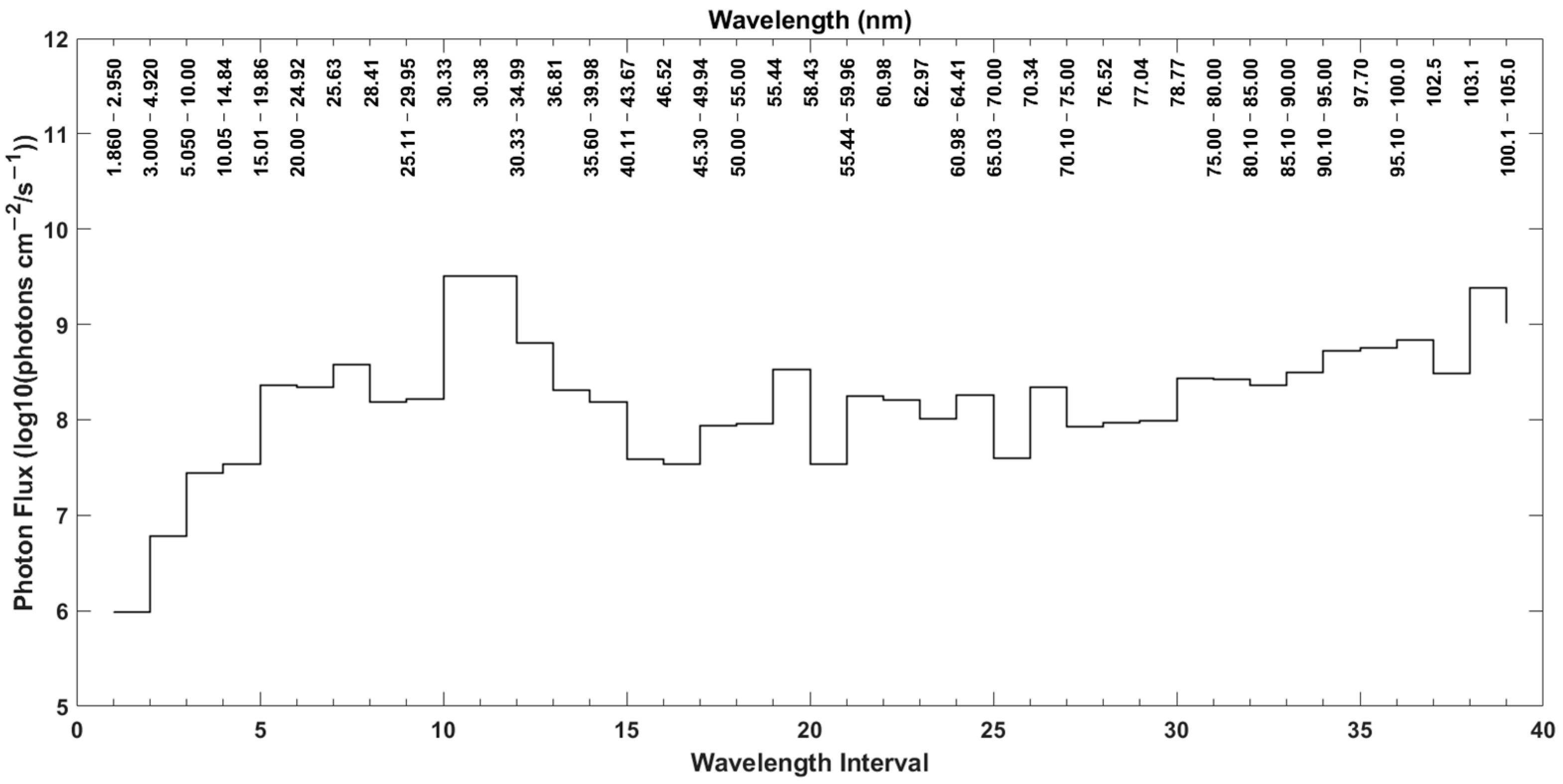

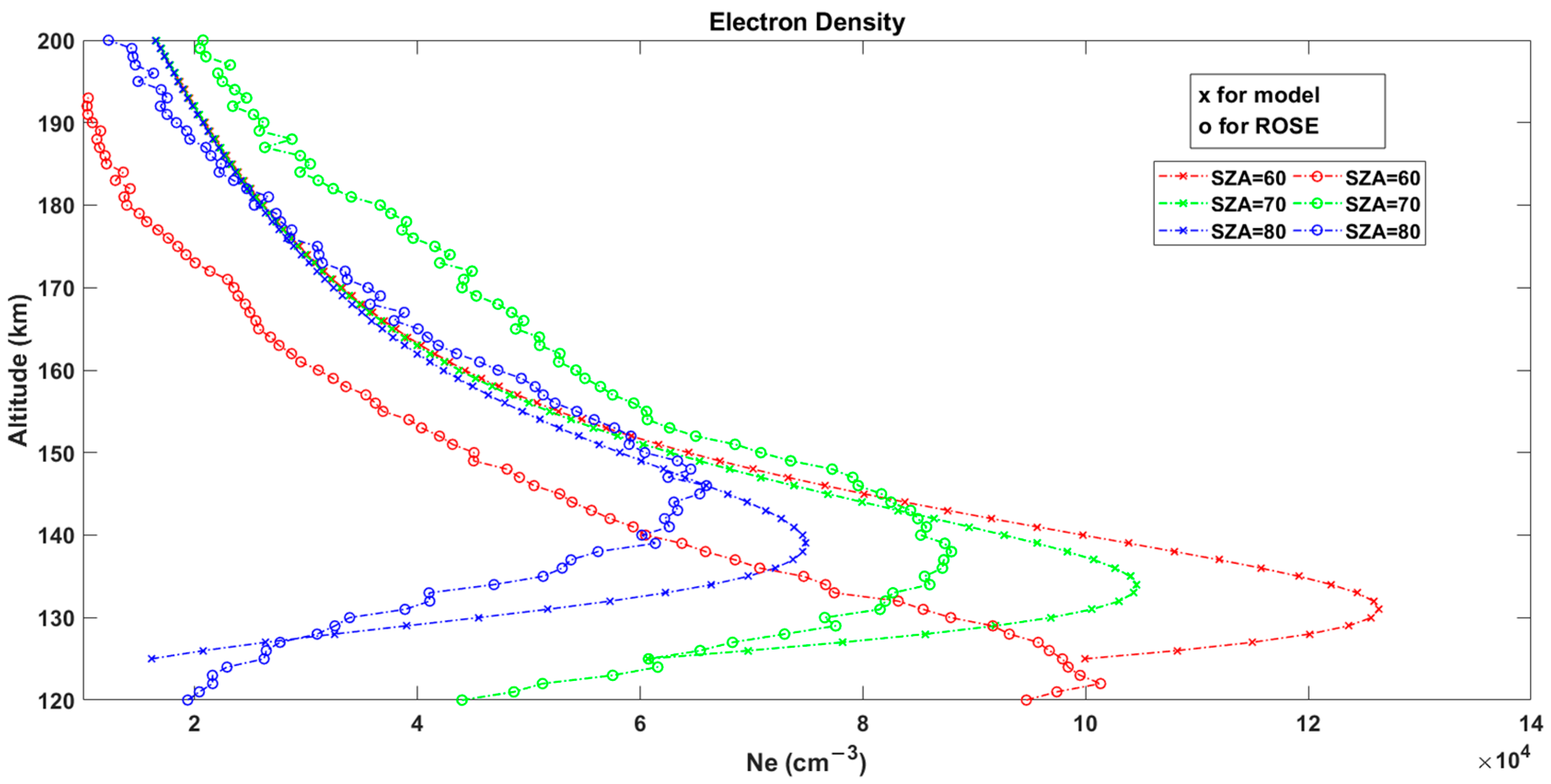
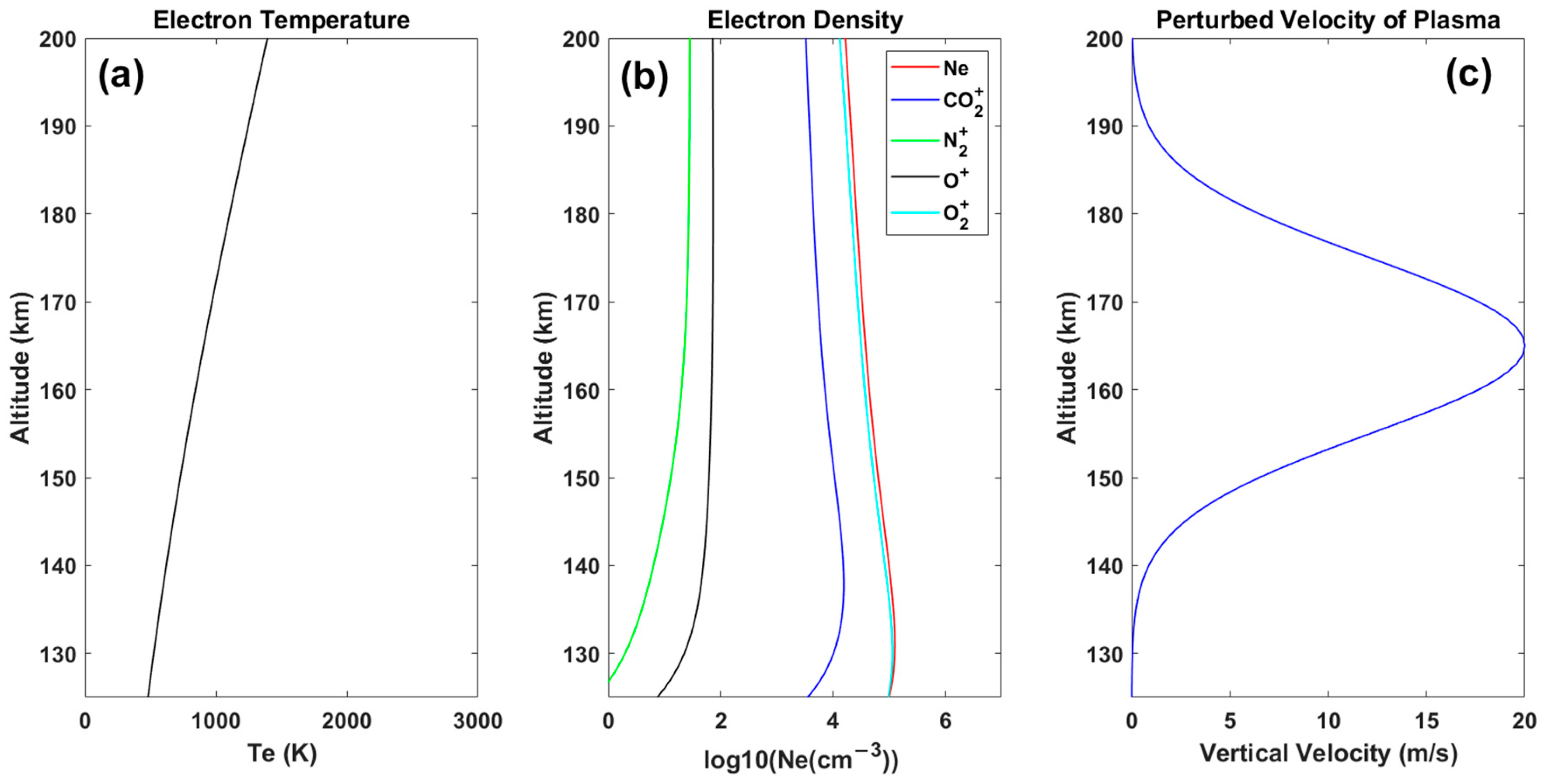
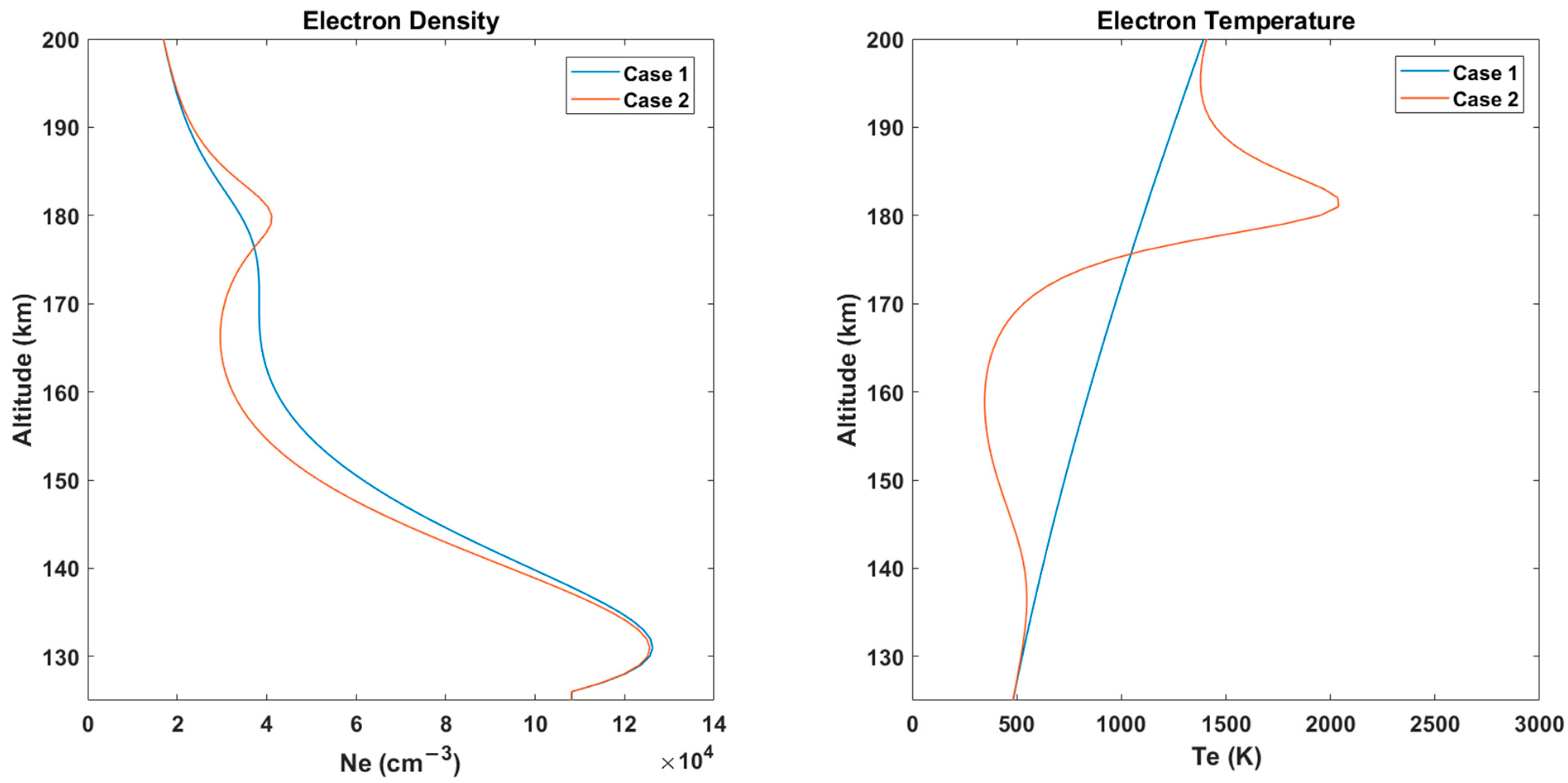
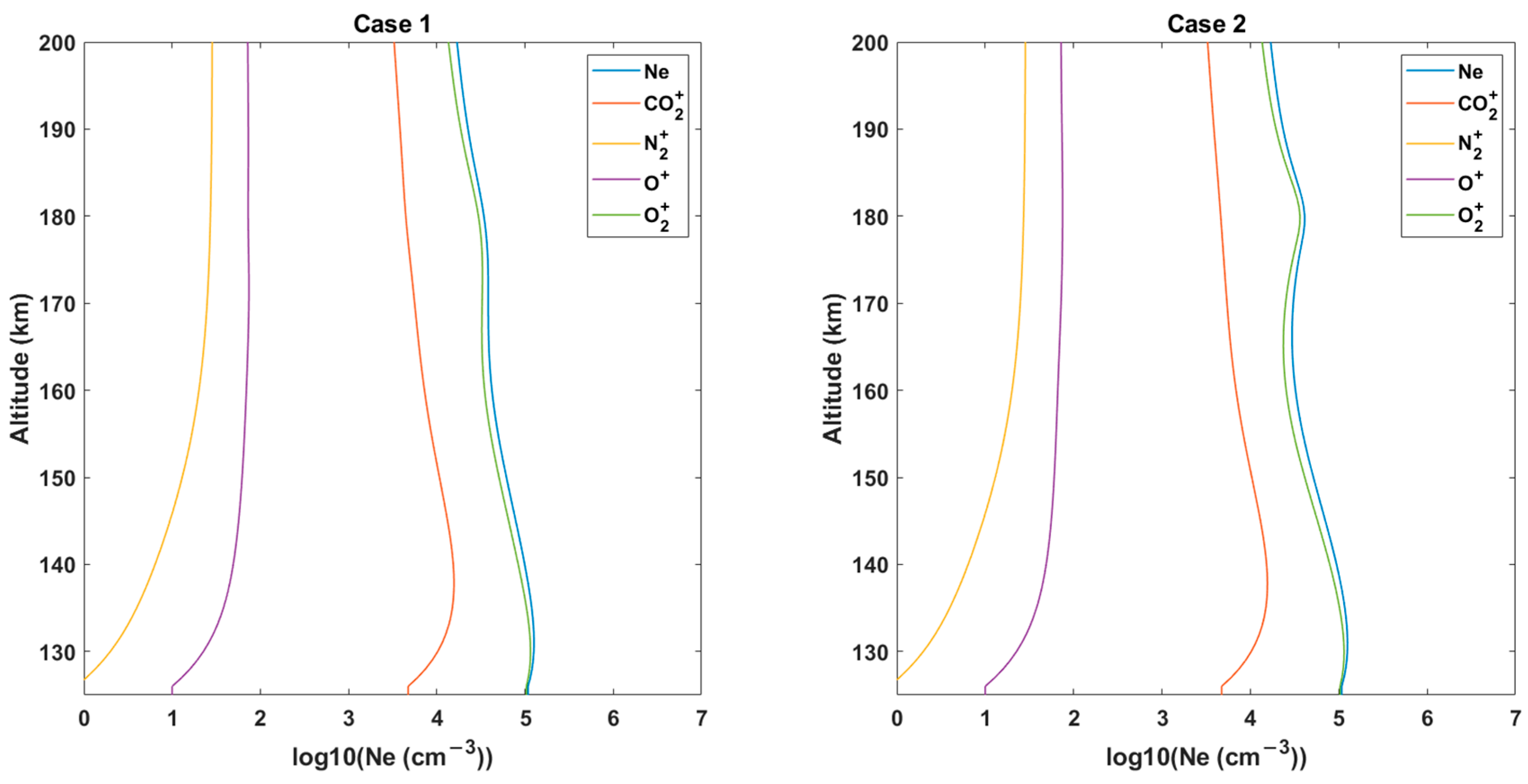
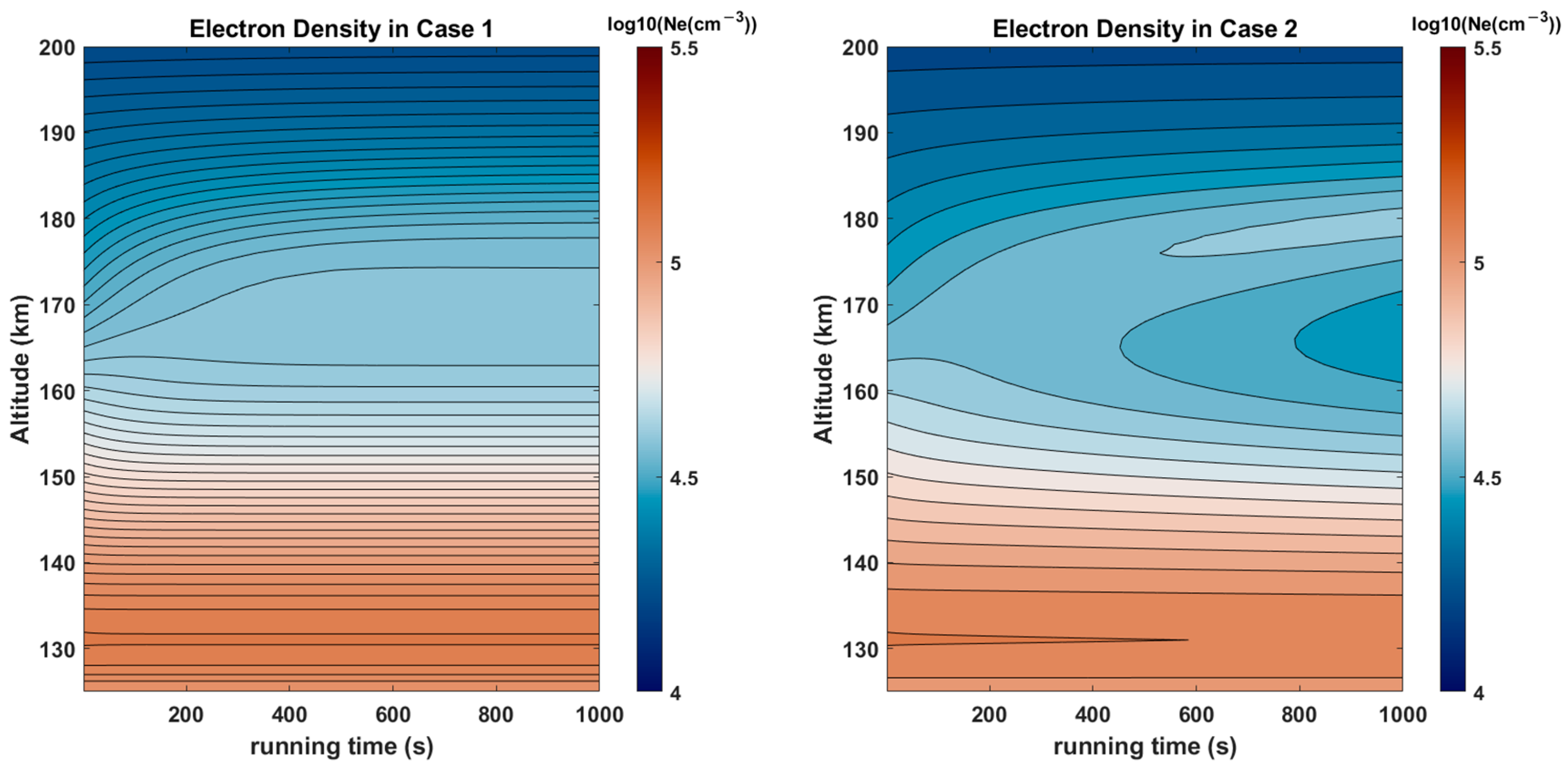
| Reaction | Rate Constant, cm3/s |
|---|---|
| (a) | |
| (b) | |
| (c) | |
| (d) | k1 = 9.6 × 10−11 |
| (e) | k2 = 1.6 × 10−10 |
| (f) | k3 = 8.0 × 10−10 |
| (g) | k4 = 9.8 × 10−12 |
| (h) | k5 = 1.3 × 10−10 |
| (i) | k6 = 1.2 × 10−12 |
| (j) | k7 = 1.1 × 10−9 |
| (k) | |
| (l) | |
| (m) | |
| (n) |
| Run Modes | Description |
|---|---|
| Case 1 | Electron temperature is constant in the simulation. |
| Case 2 | Electron temperature varies with the gradients of the electron temperature and vertical velocity, . |
Disclaimer/Publisher’s Note: The statements, opinions and data contained in all publications are solely those of the individual author(s) and contributor(s) and not of MDPI and/or the editor(s). MDPI and/or the editor(s) disclaim responsibility for any injury to people or property resulting from any ideas, methods, instructions or products referred to in the content. |
© 2023 by the authors. Licensee MDPI, Basel, Switzerland. This article is an open access article distributed under the terms and conditions of the Creative Commons Attribution (CC BY) license (https://creativecommons.org/licenses/by/4.0/).
Share and Cite
Jiang, C.; Tian, R.; Wei, L. Simulation of Transient Topside Layer in the Martian Ionosphere. Remote Sens. 2023, 15, 770. https://doi.org/10.3390/rs15030770
Jiang C, Tian R, Wei L. Simulation of Transient Topside Layer in the Martian Ionosphere. Remote Sensing. 2023; 15(3):770. https://doi.org/10.3390/rs15030770
Chicago/Turabian StyleJiang, Chunhua, Rong Tian, and Lehui Wei. 2023. "Simulation of Transient Topside Layer in the Martian Ionosphere" Remote Sensing 15, no. 3: 770. https://doi.org/10.3390/rs15030770
APA StyleJiang, C., Tian, R., & Wei, L. (2023). Simulation of Transient Topside Layer in the Martian Ionosphere. Remote Sensing, 15(3), 770. https://doi.org/10.3390/rs15030770






